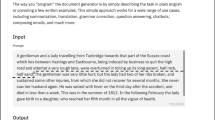Abstract
Along with the increasing popularity of connectionist language models has come a number of provocative suggestions about the challenge these models present to Chomsky's arguments for nativism. The aim of this paper is to assess these claims. We begin by reconstructing Chomsky's “argument from the poverty of the stimulus” and arguing that it is best understood as three related arguments, with increasingly strong conclusions. Next, we provide a brief introduction to connectionism and give a quick survey of recent efforts to develop networks that model various aspects of human linguistic behavior. Finally, we explore the implications of this research for Chomsky's arguments. Our claim is that the relation between connectionism and Chomsky's views on innate knowledge is more complicated than many have assumed, and that even if these models enjoy considerable success the threat they pose for linguistic nativism is small.
Similar content being viewed by others
References
Berwick, R.: 1983, ‘Using What You Know: A Computer-Science Perspective’, Behavioral and Brain Sciences 6, 402–403.
Charniak, E. and E. Santos: 1986, ‘A Connectionist Context-free Parser which is not Context-free, but then it is not Really Connectionist Either’, Department of Computer Science, Brown University.
Chomsky, N.: 1965, Aspects of the Theory of Syntax, MIT Press, Cambridge, Massachusetts.
Chomsky, N.: 1966, Cartesian Linguistics: A Chapter in the History of Rationalistic Thought, Harper and Row, New York.
Chomsky, N.: 1969, ‘Comments on Harman's Reply’, in S. Hook (ed.), Language and Philosophy, New York University Press, New York, pp. 152–159.
Chomsky, N.: 1972, Language and Mind, Harcourt Brace Jovanovich, New York.
Chomsky, N.: 1975, Reflections on Language, Pantheon Books, New York.
Chomsky, N.: 1980a, Rules and Representations, Columbia University Press, New York.
Chomsky, N.: 1980b, ‘Rules and Representations’, Behavioral and Brain Sciences 3, 1–61.
Chomsky, N.: 1980c, ‘Recent Contributions to the Theory of Innate Ideas: Summary of Oral Presentation’, in H. Morick (ed.), Challenges to Empiricism, Hackett, Indianapolis, pp. 230–40.
Chomsky, N.: 1986, Knowledge of Language, Praeger, New York.
Chomsky, N.: 1988, Language and Problems of Knowledge, MIT Press, Cambridge, Massachusetts.
Cottrell, G.: 1985, ‘Connectionist Parsing’, in Proceedings of the Seventh Annual Cognitive Science Society, pp. 201–11.
Cummins, R.: 1977, ‘Programs in the Explanation of Behavior’, Philosophy of Science 44, 269–87.
Elman, J.: 1988, ‘Finding Structure in Time’, CRL Technical Report 8801.
Fanty, M.: 1985, ‘Context-Free Parsing in Connectionist Networks’, Technical Report No. 174, Department of Computer Science, University of Rochester.
Fodor, J.: 1981, Representations, MIT Press, Cambridge, Massachusetts.
Gold, E. M. 1967, ‘Language Identification in the Limit’, Information and Control 10, 447–74.
Goodman, N.: 1965, Fact, Fiction and Forecast, 2nd ed., Bobbs Merrill, Indianapolis.
Gorman, R. and T. Sejnowski: forthcoming, ‘Learned Classification of Sonar Targets Using a Massively Parallel Network’, to appear in IEEE Transactions: Acoustics, Speech, and Signal Processing.
Hanson, S. and J. Kegl: 1987, ‘PARSNIP: A Connectionist Network that Learns Natural Language Grammar from Exposure to Natural Language Sentences’, in Proceedings of the Ninth Annual Conference of the Cognitive Science Society, pp. 106–19.
Hinton, G.: 1987, ‘Connectionist Learning Procedures’, Tech Report No. CMUCS-87-115.
Hornstein, N.: 1984, Logic as Grammar, MIT Press, Cambridge, Massachusetts.
Hornstein, N. and D. Lightfoot: 1981, Explanations in Linguistics, Longman, London.
Hornstein, N. and D. Lightfoot: 1981b, ‘Introduction’, in Hornstein and Lightfoot (1981a), pp. 9–31.
Lightfoot, D.: 1982, The Language Lottery, MIT/Bradford Press, Cambridge, Massachusetts.
McClelland, J., D. Rumelhart, and D. Hinton: 1986, ‘The Appeal of Parallel Distributed Processing’, in Rumelhart and McClelland (1986a), Vol. I.
McClelland, J. L., and A. Kawamoto: 1986, ‘Mechanisms of Sentence Processing: Assigning Roles to Constituents’, in Rumelhart and McClelland (1986a), Vol. II.
Morgan, J.: 1986, From Simple Input to Complex Grammar, MIT Press, Cambridge, Massachusetts.
Papert, S.: 1988, ‘One AI or Many?’, Daedalus 117, 1–14.
Peters, S.: 1972, ‘The Projection Problem: How is a Grammar to be Selected?’, Goals of Linguistic Theory, Prentice-Hall, Englewood Cliffs, New Jersey.
Pinker, S., and A. Prince: forthcoming, ‘On Language and Connectionism: Analysis of a Parallel Distributed Processing Model of Language Acquisition’, to appear in Cognition.
Quine, W. V.: 1969, ‘Linguistics and Philosophy’, in S. Hook (ed.), Language and Philosophy, New York University Press, pp. 95–98.
Ramsey, W., D. Rumelhart, and S. Stich: forthcoming, Philosophy and Connectionist Theory, Lawrence Erlbaum Associates, Hillsdale, New Jersey.
Ramsey, W., S. Stich and J. Garon: forthoming, ‘Connectionism, Eliminativism and the Future of Folk Psychology’, to appear in Ramsey, Rumelhart, and Stich.
Rumelhart, D., G. Hinton and J. McClelland: 1986, A General Framework for Parallel Distributed Processing’, in Rumelhart and McClelland (1986a), Vol. I.
Rumelhart, D., G. Hinton and R. Williams: 1986, ‘Learning Internal Representations by Error Propagation’, in Rumelhart and McClelland (1986a), Vol. I.
Rumelhart, D. and J. McClelland: 1986a, Parallel Distributed Processing: Explorations in the Microstructure of Cognition, Vols. I & II, MIT/Bradford Press, Cambridge, Massachusetts.
Rumelhart, D. and J. McClelland: 1986b, ‘On Learning the Past Tense of English Verbs’, in Rumelhart and McClelland (1986a), Vol. II.
Rumelhart, D. and J. McClelland: 1986c, ‘PDP Models and General Issues in Cognitive Science’, in Rumelhart and McClelland (1986a), Vol. I.
Sampson, G.: 1987a, ‘Review Article. Parallel Distributed Processing’, Language 63, 871–86.
Sampson, G.: 1987b, ‘A Turning Point in Linguistics’, Times Literary Supplement, June 12, p. 643.
Searle, J.: 1974, ‘Chomsky's Revolution in Linguistics’, in Gilbert Harman (ed.), On Noam Chomsky: Critical Essays, Doubleday, New York, pp. 2–33.
Sejnowski, T. C. Rosenberg 1987, ‘Parallel Networks that Learn to Pronounce English Text’, Complex Systems 1, 145–68.
Selman, B. and G. Hirst: 1985, ‘A Rule-Based Connectionist Parsing System’, Proceedings of the Seventh Annual Conference of the Cognitive Science Society.
St. John, M. F. and J. L. McClelland: 1988, ‘Learning and Applying Contextual Constraints in Sentence Comprehension’, in Proceedings of the 10th Annual Cognitive Science Society Conference, Lawrence Erlbaum Associates, Hillsdale, New Jersey.
Stabler, E.: 1983, ‘How Are Grammars Represented?’, Behavioral and Brain Sciences 6, 391–421.
Stich, S.: 1971, ‘What Every Speaker Knows’, Philosophical Review 80, 476–96.
Stich, S.: forthcoming, ‘The Dispute Over Innate Ideas’, to appear in M. Dascal et al. (eds.), Sprachphilosophie: Ein Internationales Handbuch Zeitgenossischer Forschung.
Waltz, D. L. and J. B. Pollack: 1985, ‘Massively Parallel Parsing: A Strongly Interactive Model of Natural Interpretation’, Cognitive Science 9, 51–74.
Wexler, K. and P. W. Culicover: 1980, Formal Principles of Language Acquisition, MIT Press, Cambridge, MA.
Author information
Authors and Affiliations
Rights and permissions
About this article
Cite this article
Ramsey, W., Stich, S. Connectionism and three levels of nativism. Synthese 82, 177–205 (1990). https://doi.org/10.1007/BF00413661
Issue Date:
DOI: https://doi.org/10.1007/BF00413661




